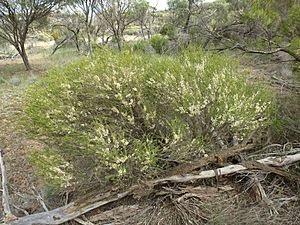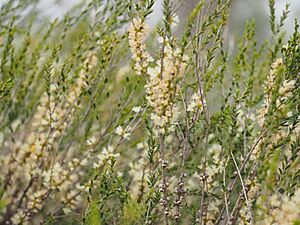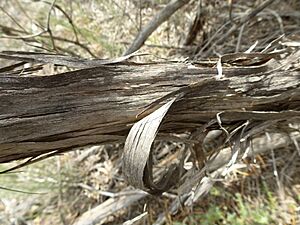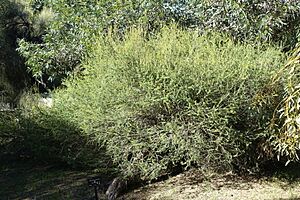Mallee honeymyrtle facts for kids
Quick facts for kids Mallee honeymyrtle |
|
|---|---|
 |
|
| Melaleuca acuminata in the Kalgarin Nature Reserve near Corrigin. | |
| Scientific classification | |
| Genus: |
Melaleuca
|
| Species: |
acuminata
|
| Subspecies | |
|
Melaleuca acuminata subsp. integrifolia |
|
| Synonyms | |
|
|
The Mallee honeymyrtle (scientific name: Melaleuca acuminata) is a type of plant that belongs to the myrtle family, called Myrtaceae. This plant grows naturally across many temperate parts of Australia. It is usually a straight, upright shrub that can grow up to about 3 meters (10 feet) tall. You often find it growing in areas known as mallee woodlands.
Contents
What Does the Mallee Honeymyrtle Look Like?
The Mallee honeymyrtle is an upright shrub with branches that grow upwards. Its bark can look like paper or have a stringy, fibrous feel.
Its leaves are arranged in a special way: they grow in pairs, with each pair at right angles to the one above it. This means they alternate on either side of the stem. The leaves are narrow and oval-shaped, about 5 to 10 millimeters (0.2 to 0.4 inches) long and 2 to 4 millimeters (0.08 to 0.16 inches) wide. Each leaf has a short stalk, called a petiole, that connects it to the stem.
The flowers are usually cream or white, but sometimes they have a hint of pink. They grow in small groups of three to six flowers. These clusters appear along the stem over a long section. The flower's stamens (the parts that produce pollen) are grouped into five bundles, often called "claws." Each claw has between 9 and 17 stamens.
The Mallee honeymyrtle blooms in spring. After the flowers, it produces smooth, woody fruits called capsules. These capsules are round, about 3 to 5 millimeters (0.12 to 0.2 inches) across, and grow either alone or in small groups.
How the Mallee Honeymyrtle Got Its Name
The scientific name Melaleuca acuminata was first given to this plant in 1858 by a scientist named Ferdinand von Mueller. He described it in his book Fragmenta Phytographiae Australiae. He found a sample of the plant on the stony hills of Mount Barker Creek.
The second part of its scientific name, acuminata, comes from a Latin word meaning "sharp point." This refers to the pointed tips of the plant's leaves.
Different Types of Mallee Honeymyrtle
There are two main types, or subspecies, of Mallee honeymyrtle. They differ slightly in their leaf sizes and where they grow:
- Melaleuca acuminata subspecies acuminata: This type is found in Western Australia, South Australia, Victoria, and the southwestern part of New South Wales.
- Melaleuca acuminata subspecies websteri: This type only grows in Western Australia. It has narrower leaves than the other subspecies. The name websteri honors Leonard Clarke Webster, who was an Australian plant collector and later a doctor.
Where the Mallee Honeymyrtle Grows
The Mallee honeymyrtle is found in several parts of Australia. In Western Australia, it grows in regions like Carnarvon and Coolgardie. In South Australia, you can find it in the far southeastern corner. It also grows in western Victoria and is rare in New South Wales, found only in the Balranald area.
This plant likes to grow in mallee communities. In New South Wales, it often grows on sandhills. In other areas, it can be found in sandy or clay soils, sometimes in swampy areas or on small hills. It can even grow in salty conditions.
Is the Mallee Honeymyrtle Protected?
The Mallee honeymyrtle is currently considered "not threatened" by the Government of Western Australia's Department of Parks and Wildlife. This means it is not in danger of disappearing.
Growing Mallee Honeymyrtle in Gardens
This type of melaleuca is quite adaptable and easy to grow. If it gets enough water, it can grow even more strongly than it does in the wild.




